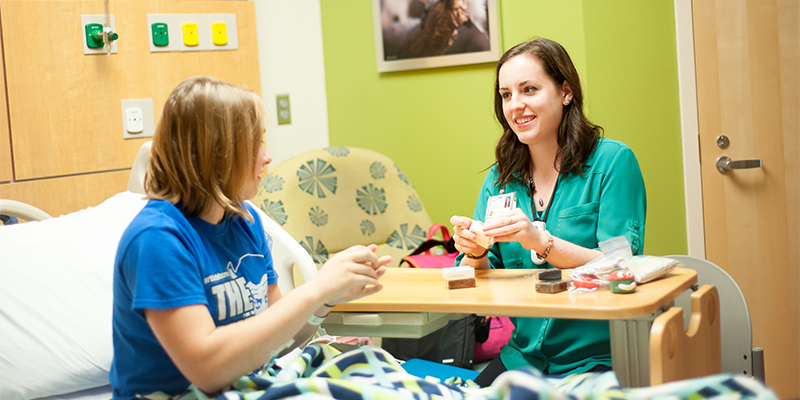

Expressing the inexpressible through art therapy
Part 1 of a two-part series, Beat Stress by Making Art
By Karen O'Hara, university communications
Science tells us that physical activity benefits both the body and the mind. A quick run or swim can renew our mental focus for reading or studying.
Science also tells us that creating and appreciating art can boost our emotional health, preparing us to deal with life's challenges.
Pediatric medical art therapist Emily Allbery (Miami Class of 2012) works with patients and their families within a children’s hospital. According to Allbery, art therapy is not about what the finished product looks like, but that it makes you feel something.
Allbery recalls a patient who was facing a particularly high level of stress. Due to a combination of infection control protocol for their illness and a pending foster care placement, the child was confined to a hospital room for an entire month. Facing an uncertain future, the child used art to work through the anxiety.
“This patient created houses, structures, and homes for all their toys and dolls,” Allbery says. “We were able to discuss what makes a home safe and what it’s like when things change, all through artwork. Everything was processed in a safe, non-threatening environment before the foster home placement was finalized.”
Another case involved the family of a dying child who was comatose. Throughout this challenging time, Allbery worked with the child’s mother on writing and illustrating a book for her to read to her child, as well as paintings and
A few months later, the mother sent Allbery a short email, thanking her for helping the family, and dubbing her a ‘true MVP.’ “It’s moments like these that you can witness the extended effects of art therapy on a person’s life,” Allbery says.
From artist to art therapist
Allbery’s own life-changing moment came in high school when a guidance counselor told her about the field of art therapy. Trained as traditional psychotherapists, art therapists complete additional coursework on how to use art as a tool for communication, processing, and therapeutic goals. Allbery was immediately intrigued.
“I was hooked by the idea of using the artistic process to help other people,” she says. “Individuals who might not have words to define what they are experiencing are able to share and articulate their emotions, feelings, or trauma through visual images.”
After she earned her undergraduate degree in art education and painting from Miami, Allbery completed her master’s degree in art therapy from the School of the Art Institute of Chicago. In 2014, she began working as a registered art therapist at Riley Hospital for Children at IU Health in Indianapolis.
And when Miami launched a minor in art therapy, Allbery added a position as a part-time instructor to her busy schedule.
Art makes you feel something
You needn’t be one of Allbery’s students or patients to use art to work through your own stressors.
“When people think of art, they typically think painting and drawing. But how we dress, what we cook, how we decorate our home—these are all art forms and a form of expression,” she says. “Techniques like journal writing, sculpture, and clay work make art accessible to everyone.”
Allbery adds, “As one of my favorite professors at Miami, Matthew Litteken, said, ‘A person typically looks at a piece of art for 3 seconds. If they look at it for longer, whether they love it or hate it, then you’ve done your job as an artist because you’ve made them feel something.’”
Emily Allbery will participate in a panel of local service providers in the video chat “Intervention with Children: How to Help" on April 17 from 8:30 a.m. - 9:30 a.m. on the Middletown campus in Room 120, Johnston Hall
